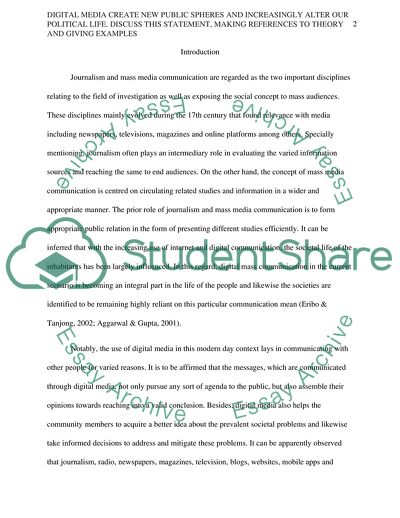Cite this document
(Digital Media Create New Public Spheres and Increasingly Alter Our Political Life Literature review Example | Topics and Well Written Essays - 4750 words, n.d.)
Digital Media Create New Public Spheres and Increasingly Alter Our Political Life Literature review Example | Topics and Well Written Essays - 4750 words. https://studentshare.org/media/1855197-digital-media-create-new-public-spheres-and-increasingly-alter-our-political-life-discuss-this-statement-making-references-to-theory-and-giving-examples
Digital Media Create New Public Spheres and Increasingly Alter Our Political Life Literature review Example | Topics and Well Written Essays - 4750 words. https://studentshare.org/media/1855197-digital-media-create-new-public-spheres-and-increasingly-alter-our-political-life-discuss-this-statement-making-references-to-theory-and-giving-examples
(Digital Media Create New Public Spheres and Increasingly Alter Our Political Life Literature Review Example | Topics and Well Written Essays - 4750 Words)
Digital Media Create New Public Spheres and Increasingly Alter Our Political Life Literature Review Example | Topics and Well Written Essays - 4750 Words. https://studentshare.org/media/1855197-digital-media-create-new-public-spheres-and-increasingly-alter-our-political-life-discuss-this-statement-making-references-to-theory-and-giving-examples.
Digital Media Create New Public Spheres and Increasingly Alter Our Political Life Literature Review Example | Topics and Well Written Essays - 4750 Words. https://studentshare.org/media/1855197-digital-media-create-new-public-spheres-and-increasingly-alter-our-political-life-discuss-this-statement-making-references-to-theory-and-giving-examples.
“Digital Media Create New Public Spheres and Increasingly Alter Our Political Life Literature Review Example | Topics and Well Written Essays - 4750 Words”. https://studentshare.org/media/1855197-digital-media-create-new-public-spheres-and-increasingly-alter-our-political-life-discuss-this-statement-making-references-to-theory-and-giving-examples.


